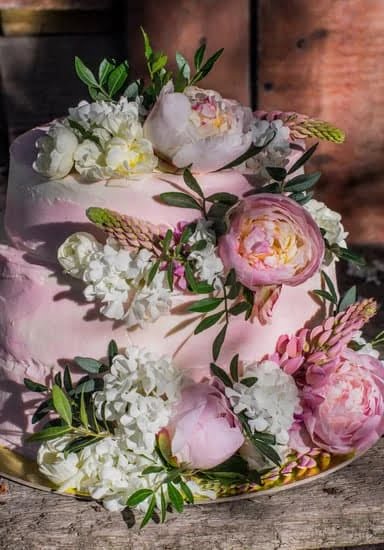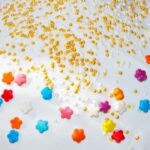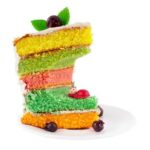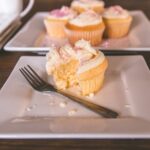Baking is not just about serving delicious treats; it is an opportunity to unleash your creativity and create edible works of art. There’s something truly magical about transforming basic ingredients like flour, sugar, eggs, and butter into a beautifully decorated cake that is sure to impress. Whether you are a seasoned baker or just starting out, decorating cakes can bring immense joy and satisfaction.
The best cake to make for decorating largely depends on personal preference and the design you have in mind. However, one tried-and-true option that is perfect for decorators of all skill levels is the classic vanilla sponge cake. Its light and fluffy texture provides a great canvas for various decorative techniques, while its subtle flavor pairs well with a wide range of fillings and frostings.
When it comes to decorating cakes, choosing the right base recipe is crucial. In section 2 of this article, we will dive into an exploration of the best cake recipes for decorators. From chocolate to red velvet to lemon chiffon, we will discuss different cake flavors that work well for various styles of decoration. Additionally, we will explore the importance of moisture and flavor when achieving the ideal cake texture for decorating in section 3.
So grab your apron, preheat your oven, and get ready to embark on a creative journey with us as we delve into the world of cake decoration. In the following sections, we will cover everything from design ideas and essential tools to expert tips and advanced techniques. By the end of this article, you’ll be armed with all the knowledge you need to create stunning cakes that not only taste amazing but also look like masterpieces.
Picking the Perfect Base
Choosing the right cake recipe is essential when it comes to decorating a cake. The texture, flavor, and sturdiness of the cake can greatly affect the outcome of your decoration. Here are some of the best cake recipes that decorators swear by:
- Vanilla Sponge Cake: A classic choice for cake decorators, this light and fluffy cake provides a sturdy base for intricate designs. Its neutral flavor allows you to experiment with different fillings and frostings while still letting the decoration take center stage.
- Chocolate Devil’s Food Cake: For chocoholics, this rich and moist cake is a popular choice. Its deep chocolate flavor pairs well with various decorations, such as chocolate ganache or buttercream frosting.
- Red Velvet Cake: With its vibrant red color and subtle cocoa taste, red velvet cake is not only visually appealing but also delicious. It works well with cream cheese frosting or white chocolate ganache, making it a versatile option for different design ideas.
- Lemon Pound Cake: If you prefer a tangy and refreshing flavor, lemon pound cake is perfect for you. The dense yet tender crumb of this cake makes it easy to work with fondant or buttercream frosting.
Each of these cake recipes has its own unique characteristics that make them suitable for decorating purposes. It’s important to choose a recipe that suits your personal taste preferences as well as the type of design you have in mind.
| Cake Recipe | Best For |
|---|---|
| Vanilla Sponge Cake | Intricate designs |
| Chocolate Devil’s Food Cake | Chocolate-themed decorations |
| Red Velvet Cake | Colorful and versatile designs |
| Lemon Pound Cake | Tangy and refreshing decorations |
Remember, the best cake recipe for decorating ultimately depends on your personal preferences and the specific design you want to achieve. Experimenting with different recipes and flavors can help you discover your favorite go-to base for all your cake decoration projects.
Moist and Flavorful
When it comes to cake decoration, achieving the ideal cake texture is essential. A moist and flavorful cake not only provides a delicious base for your decorations but also ensures that the final product is enjoyable to eat. There are several key steps you can take to achieve the perfect texture for your decorating needs.
Firstly, choosing the right recipe is crucial. Look for cake recipes that prioritize moisture and tenderness. Butter-based cakes, such as a classic vanilla or chocolate cake, often yield excellent results. The creaming method, where butter and sugar are beaten together until light and fluffy, helps create a tender crumb.
In addition to selecting the right recipe, proper mixing techniques play a role in achieving an ideal cake texture. Overmixing can result in a dense and tough cake, while undermixing can lead to uneven distribution of ingredients. Be sure to follow the recipe instructions closely and mix just until the ingredients are incorporated.
Another important factor in achieving a moist cake texture is proper baking time and temperature. Overbaking can dry out the cake, so it’s important to closely monitor the baking process. Use a toothpick or skewer inserted into the center of the cake to check for doneness. If it comes out clean or with just a few crumbs clinging to it, it’s ready.
By following these tips for achieving an ideal cake texture, you’ll have a perfect canvas for your decorations. A moist and flavorful base will not only enhance the visual presentation of your creation but will also ensure that every bite delights your taste buds.
Showcasing Your Creativity
When it comes to cake decoration, the possibilities are endless. It is the perfect opportunity to let your creativity run wild and create a stunning edible art piece that will leave everyone impressed. In this section, we will explore some top design ideas for cake decoration that will help you showcase your artistic skills.
Fondant Sculptures
One of the most popular design ideas for cake decoration is creating fondant sculptures. Fondant is a type of icing that can be rolled out like dough and used to cover cakes with smooth, flawless finishes. However, it can also be molded and shaped into intricate designs such as flowers, animals, and even people. The beauty of fondant sculptures is that they can be customized according to any theme or occasion, making them a versatile choice for decorators.
Ombré Effects
Ombré effects are another trendy design idea for cake decoration that adds visual interest and depth to your creation. This technique involves blending different shades of the same color from light to dark, creating a gradient effect. It can be achieved by using an airbrush or by hand-painting the colors onto the cake. Ombré effects work particularly well with buttercream icing or whipped cream as they allow for smooth blending.
Geometric Patterns
Geometric patterns are a modern and sleek design idea for cake decoration that adds a touch of sophistication to any dessert table. Whether it’s hexagons, chevron stripes, or intricate lattice work, geometric patterns can be achieved through various techniques such as stenciling or piping royal icing onto the cake surface. It is important to plan out the pattern beforehand and ensure precision in order to achieve clean lines and sharp angles.
Essential Tools and Techniques
When it comes to cake decoration, having the right tools and techniques can make all the difference in creating a successful masterpiece. Whether you’re a beginner or an experienced decorator, there are certain supplies that are essential for achieving professional-looking results. Here are some must-have supplies for successful cake decoration:
Cake Decorating Turntable
A cake turntable is a rotating platform that allows you to easily spin your cake while decorating. This tool is essential for achieving smooth icing and even designs. It makes it easier to reach all sides of the cake without having to constantly move around.
Piping Bags and Tips
Piping bags are used to pipe frosting onto the cake in various patterns and designs. They come in different sizes and materials, such as disposable plastic or reusable cloth. Coupled with piping tips, which come in different shapes and sizes, they allow you to create intricate details like borders, flowers, and writing on cakes.
Icing Smoother
An icing smoother is a flat tool that helps achieve a smooth surface on frosted cakes. It helps remove any imperfections or air bubbles from the icing, resulting in a polished finish.
Gel Food Coloring
Gel food coloring is preferred by decorators because it produces vibrant colors without affecting the consistency of the icing or batter. Unlike liquid food coloring, gel colors do not water down the mixture, allowing for more precise color mixing and achieving the desired shades.
Offset Spatula
An offset spatula is a versatile tool used for spreading and smoothing frosting on cakes. Its angled blade makes it easier to control while applying icing layers or creating textured designs.
In addition to these essentials, other tools such as cake levelers, cake boards or stands, stencils, and edible glitter can further enhance your cake decoration skills. As you continue to build your collection of supplies, experiment with different techniques and discover what works best for you. Remember that practice and patience are key to mastering the art of cake decoration.
From Classic to Trendy
Cake decoration is an art form that allows for endless creativity. From classic designs to trendy and experimental styles, there are a plethora of options to explore when it comes to decorating cakes. In this section, we will delve into the different cake decorating styles that you can try out to make your creations truly unique.
One classic style of cake decoration is the traditional buttercream frosting. Buttercream frosting is smooth, creamy, and versatile, making it perfect for creating intricate designs like flowers, swirled patterns, or even writing messages on cakes. This style is timeless and has been loved by cake decorators for generations.
For those looking for a more modern approach, fondant cake decoration offers endless opportunities. Fondant is a pliable icing that can be rolled out and draped over cakes, providing a smooth and flawless finish. It allows decorators to create sharp edges and intricate details with ease. Fondant also provides a blank canvas for artists to paint or sculpt their designs onto the cakes.
Another trendy style in cake decoration is the naked or semi-naked cake design. This style embraces the natural beauty of the cake itself by leaving parts of it exposed or minimally frosted. The result is a rustic and organic look that is perfect for boho-themed weddings or casual celebrations.
| Cake Decorating Style | Description |
|---|---|
| Classic Buttercream | Smooth and creamy frosting with intricate piping designs. |
| Fondant | A flawless finish with sharp edges and intricate details. |
| Naked/Semi-Naked | A rustic look that embraces the natural beauty of the cake. |
These are just a few examples, and there are countless other cake decorating styles to explore. Whether you prefer a traditional look or want to try out the latest trends, experimenting with different styles can take your cake decoration skills to new heights. So don’t be afraid to get creative and make your cakes truly stand out.
Expert Tips and Tricks
When it comes to cake decoration, there are certain tips and tricks that professionals swear by to achieve flawless results. Whether you are a beginner or an experienced decorator looking to up your game, incorporating these secrets into your process can make all the difference in creating stunning cakes. Here are some expert tips and tricks to help you take your cake decoration skills to the next level:
- Plan Ahead: Before you start decorating your cake, take some time to plan out your design. Visualize how you want the final product to look like and make a rough sketch if needed. Planning ahead allows you to organize your ideas and ensures that every element of your design comes together seamlessly.
- Crumb Coat: One secret technique that professional decorators always use is the crumb coat. This involves applying a thin layer of frosting or ganache to seal in any loose crumbs on the cake before layering on the final coat of frosting. The crumb coat creates a smooth canvas for decorating and prevents any stray crumbs from ruining your design.
- Using Templates: Another great tip is to use templates for intricate designs or shapes like flowers, letters, or numbers. Templates can be made from cardstock or acetate sheets and allow you to easily trace or cut out precise shapes for consistent decorations every time.
- Piping Techniques: Piping is a fundamental skill in cake decoration, and there are various techniques that can create different effects. For example, using a round tip for piping will create smooth lines and borders, while star tips can be used for textured decorations like rosettes or shells. Practice different piping techniques with buttercream or royal icing to master them before applying them to your cakes.
These expert tips and tricks are just a starting point for enhancing your cake decoration skills. Experimenting with different techniques, tools, and styles will allow you to find your own unique approach and create stunning cakes that amaze both you and your guests. Remember, practice makes perfect, so don’t be afraid to try new things and keep honing your skills. With time and dedication, you’ll become a true pro at flawless cake decoration.
Taking it to the Next Level
Experienced cake decorators are always looking for ways to take their skills to the next level and challenge themselves with advanced techniques. While basic decorating skills are essential, mastering advanced techniques can elevate your cakes into works of art. In this section, we will explore some of the top advanced techniques for experienced decorators.
One advanced technique that is sure to impress is sugar flower arrangements. Creating delicate and realistic flowers out of sugar paste requires a steady hand and practice, but the results are stunning. Sugar flowers can be used to adorn cake tiers or create beautiful bouquets as centerpieces. By learning different flower-making techniques and experimenting with color and arrangement, experienced decorators can showcase their creativity and create show-stopping cakes.
Another advanced technique that can add a wow factor to your cake is cake sculpting. Sculpted cakes involve carving and shaping the cake to create unique designs and structures. From three-dimensional characters to intricate shapes like cars or buildings, sculpted cakes require precision and patience. This technique allows experienced decorators to push the boundaries of traditional cake design and create truly one-of-a-kind creations that are sure to amaze guests.
Finally, airbrushing is an advanced technique that can give your cakes a professional finish. Using an airbrush tool, decorators can apply food coloring in a smooth and even manner, creating gradients, shadows, and highlighting effects that add depth and dimension to their designs. Whether you want to achieve a realistic painting effect or create vibrant backgrounds with intricate details, mastering airbrushing techniques will take your cake decoration skills to new heights.
Wow Your Guests
When it comes to cake decorating, not only is the visual appeal important, but also the taste. After all, what good is a beautifully decorated cake if it doesn’t impress your guests with its flavor? In this section, we will explore some of the best cake flavors and combinations that are sure to wow your guests every time.
Classic Flavors with a Twist
For those who appreciate timeless flavors with a modern twist, consider trying classic cake flavors with unique add-ins or fillings. For example, a traditional vanilla sponge cake can be transformed into a showstopper by adding fresh berries or a decadent layer of salted caramel in between each layer. Similarly, a chocolate cake can be taken up a notch by incorporating espresso into the batter for an intense flavor experience.
Exotic Flavor Combinations
If you’re feeling adventurous and want to surprise your guests with unexpected flavor combinations, there are plenty of options to explore. Consider pairing tropical flavors like coconut and pineapple in a light and fluffy chiffon cake. Or perhaps try infusing floral notes into your cakes using ingredients such as lavender or rosewater. These unique flavor combinations will leave your guests intrigued and delighted.
Decadent Indulgences
When you really want to impress, opt for cakes that are rich and indulgent. Think velvety red velvet layered with cream cheese frosting or a dense chocolate fudge cake topped with ganache and fresh raspberries. These luxurious flavors are sure to satisfy even the most discerning palates and create a memorable dessert experience.
Remember, when choosing the best cake flavors and combinations for your guests, it’s important to consider their preferences as well as any dietary restrictions they may have. By offering a variety of flavor options and accommodating special dietary needs such as gluten-free or vegan alternatives, you can ensure that everyone at your gathering will be able to indulge and enjoy the cake.
With these impressive cake flavors and combinations, you’ll be sure to leave a lasting impression on your guests.
Final Touches
In conclusion, the final touches on a cake can truly elevate your decoration game and leave a lasting impression on your guests. After selecting the perfect base cake recipe that suits your needs, achieving an ideal texture, and exploring different design ideas and styles, it’s time to focus on those finishing details that will make your cake stand out.
Adding finishing details to your cake can be both fun and creative. From piping intricate designs with buttercream frosting to using fondant to create delicate flowers or other decorative elements, there are endless possibilities to explore. You can also experiment with adding edible accents like sprinkles, glitter, or even fresh fruits or flowers for a pop of color and texture.
To successfully execute these final touches, it is important to have the right tools and techniques at hand. Investing in quality decorating tools such as piping bags, tips of various shapes and sizes, spatulas, and cake turntables will enable you to achieve precise and professional-looking results. Familiarizing yourself with techniques like piping rosettes or creating smooth buttercream finishes will further enhance your ability to add those impeccable finishing details.
For experienced decorators looking to take their skills to the next level, exploring advanced techniques is a great way to challenge yourself. This could include techniques like painting on cakes using food coloring or creating edible sculptures as part of your cake design. These advanced techniques require practice and patience but can result in truly exceptional creations that will impress even the most discerning guests.
In summary, paying attention to the final touches of your cake decoration is crucial for achieving a professional look. By incorporating skillful piping work, fondant designs, edible accents, and investing in quality tools and learning advanced techniques if desired, you can elevate your cake decoration game and wow your guests every time. So go ahead and let your creativity shine through those finishing details – happy decorating.
Frequently Asked Questions
What kind of cake is easiest to decorate?
When it comes to decorating cakes, the easiest type of cake to work with is typically a sheet cake. Sheet cakes have flat surfaces that provide a smooth canvas for decorations. Their shape and size make them ideal for creating various designs, from simple patterns to more intricate artwork.
Moreover, sheet cakes are straightforward to cut into different shapes and sizes, allowing for easy customization based on your desired theme or design. Overall, due to their simplicity and versatility, decorating sheet cakes tend to be less challenging compared to other types of cakes.
How to make the best decorating cake?
To make the best decorating cake, several key factors should be considered. Firstly, selecting the right type of cake is crucial as some cakes are better suited for decorating due to their texture and stability, such as butter-based or sponge cakes. It’s essential to ensure that the cake is appropriately leveled before decorating by trimming any uneven areas. Secondly, using a crumb coat is highly recommended before applying the final layer of frosting or icing.
This thin layer seals in any crumbs and provides a smooth foundation for further decorations. Additionally, utilizing different tools like piping bags, spatulas, and stencils can enhance your ability to create detailed and visually appealing designs on the cake. Lastly, practicing patience and having a steady hand during the decoration process will contribute greatly to achieving a beautifully decorated cake.
What are the best cake and frosting combinations?
The best cake and frosting combinations greatly depend on personal preferences; however, there are classic pairings that consistently deliver delightful flavors harmoniously. One such combination is chocolate cake with cream cheese frosting. The richness of the chocolate complements the tanginess of cream cheese frosting exceptionally well, creating a balanced taste experience that pleases many palates.

Welcome to our cake decorating blog! My name is Destiny Flores, and I am the proud owner of a cake decorating business named Cake Karma. Our mission is to provide delicious, beautiful cakes for all occasions. We specialize in creating custom cakes that are tailored specifically to each customer’s individual needs and tastes.





